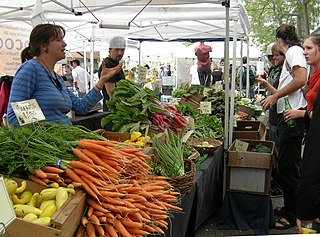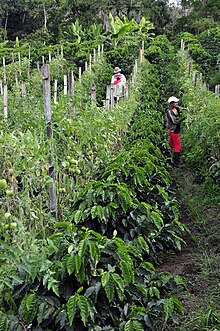
The cocoa bean or simply cocoa, also called cacao, is the dried and fully fermented seed of Theobroma cacao, the cacao tree, from which cocoa solids and cocoa butter can be extracted. Cocoa trees are native to the Amazon rainforest. They are the basis of chocolate and Mesoamerican foods including tejate, an indigenous Mexican drink.
Agroecology is an academic discipline that studies ecological processes applied to agricultural production systems. Bringing ecological principles to bear can suggest new management approaches in agroecosystems. The term can refer to a science, a movement, or an agricultural practice. Agroecologists study a variety of agroecosystems. The field of agroecology is not associated with any one particular method of farming, whether it be organic, regenerative, integrated, or industrial, intensive or extensive, although some use the name specifically for alternative agriculture.

Food sovereignty is a food system in which the people who produce, distribute, and consume food also control the mechanisms and policies of food production and distribution. This stands in contrast to the present corporate food regime, in which corporations and market institutions control the global food system. Food sovereignty emphasizes local food economies, sustainable food availability, and centers culturally appropriate foods and practices. Changing climates and disrupted foodways disproportionately impact indigenous populations and their access to traditional food sources while contributing to higher rates of certain diseases; for this reason, food sovereignty centers indigenous peoples. These needs have been addressed in recent years by several international organizations, including the United Nations, with several countries adopting food sovereignty policies into law. Critics of food sovereignty activism believe that the system is founded on inaccurate baseline assumptions; disregards the origins of the targeted problems; and is plagued by a lack of consensus for proposed solutions.

La Vía Campesina is an international farmers organization founded in 1993 in Mons, Belgium, formed by 182 organisations in 81 countries, and describing itself as "an international movement which coordinates peasant organizations of small and middle-scale producers, agricultural workers, rural women, and indigenous communities from Asia, Africa, America, and Europe".

Urban agriculture refers to various practices of cultivating, processing, and distributing food in urban areas. The term also applies to the area activities of animal husbandry, aquaculture, beekeeping, and horticulture in an urban context. Urban agriculture is distinguished from peri-urban agriculture, which takes place in rural areas at the edge of suburbs.

A smallholding or smallholder is a small farm operating under a small-scale agriculture model. Definitions vary widely for what constitutes a smallholder or small-scale farm, including factors such as size, food production technique or technology, involvement of family in labor and economic impact. Smallholdings are usually farms supporting a single family with a mixture of cash crops and subsistence farming. As a country becomes more affluent, smallholdings may not be self-sufficient, but may be valued for the rural lifestyle. As the sustainable food and local food movements grow in affluent countries, some of these smallholdings are gaining increased economic viability. There are an estimated 500 million smallholder farms in developing countries of the world alone, supporting almost two billion people.

Urban horticulture is the science and study of the growing plants in an urban environment. It focuses on the functional use of horticulture so as to maintain and improve the surrounding urban area. Urban horticulture has seen an increase in attention with the global trend of urbanization and works to study the harvest, aesthetic, architectural, recreational and psychological purposes and effects of plants in urban environments.
Agriculture continued to be the mainstay of the economy of Haiti in the late 1980s; it employed approximately 66 percent of the labor force and accounted for about 35 percent of GDP and for 24 percent of exports in 1987. The role of agriculture in the economy has declined severely since the 1950s, when the sector employed 80 percent of the labor force, represented 50 percent of GDP, and contributed 90 percent of exports. Many factors have contributed to this decline. Some of the major ones included the continuing fragmentation of landholdings, low levels of agricultural technology, migration out of rural areas, insecure land tenure, a lack of capital investment, high commodity taxes, the low productivity of undernourished animals, plant diseases, and inadequate infrastructure. Neither the government nor the private sector invested much in rural ventures; in FY 1989 only 5 percent of the national budget went to the Ministry of Agriculture, Natural Resources, and Rural Development. As Haiti entered the 1990s, however, the main challenge to agriculture was not economic, but ecological. Extreme deforestation, soil erosion, droughts, flooding, and the ravages of other natural disasters had all led to a critical environmental situation.

Shade-grown coffee is a form of the crop produced from coffee plants grown under a canopy of trees. A canopy of assorted types of shade trees is created to cultivate shade-grown coffee. Because it incorporates principles of natural ecology to promote natural ecological relationships, shade-grown coffee can be considered an offshoot of agricultural permaculture or agroforestry. The resulting coffee can be marketed as "shade-grown".
The term food system describes the interconnected systems and processes that influence nutrition, food, health, community development, and agriculture. A food system includes all processes and infrastructure involved in feeding a population: growing, harvesting, processing, packaging, transporting, marketing, consumption, distribution, and disposal of food and food-related items. It also includes the inputs needed and outputs generated at each of these steps. Food systems fall within agri-food systems, which encompass the entire range of actors and their interlinked value-adding activities in the primary production of food and non-food agricultural products, as well as in food storage, aggregation, post-harvest handling, transportation, processing, distribution, marketing, disposal, and consumption. A food system operates within and is influenced by social, political, economic, technological and environmental contexts. It also requires human resources that provide labor, research and education. Food systems are either conventional or alternative according to their model of food lifespan from origin to plate. Food systems are dependent on a multitude of ecosystem services. For example, natural pest regulations, microorganisms providing nitrogen-fixation, and pollinators.
Eric Holt Giménez is an agroecologist, political economist, lecturer and author. From 1975 to 2002 he worked in Mexico, Central America and South Africa in sustainable agricultural development. During this time he helped to start the Campesino a Campesino Movement. He returned to the U.S. twice during this period: once for his M.Sc. in international agricultural development and then for his Ph.D. in environmental studies. His dissertation research was the basis for his first book Campesino a Campesino: Voices from the farmer-to-farmer movement for sustainable agriculture in Latin America. After receiving his Ph.D. with an emphasis in agroecology and political economy, he taught as a university lecturer at UC Santa Cruz and Boston University in the International Honors Program in Global Ecology. He gives yearly courses of food systems transformation and social movements in Italy in the Masters program of the University of Gastronomic Sciences in Pollenzo and in the doctoral program at the Universidad de Antioquia in Medellín, Colombia. His work has appeared in The New York Times, The Herald Tribune, Le Monde Diplomatique, La Jornada and The Des Moines Register. He has a blog on the Huffington Post.
Occupy the Farm is an ongoing social movement that started with the 2012 occupation of the Gill Tract in Albany, California, in protest of planned commercial development of public land and in support of preserving the land for the creation of an open center for urban agroecology and food sovereignty.
Agrarian socialism is a political ideology that promotes social ownership of agrarian and agricultural production as opposed to private ownership. Agrarian socialism involves equally distributing agricultural land among collectivized peasant villages. Many agrarian socialist movements have tended to be rural, locally focused, and traditional. Governments and political parties seeking agrarian socialist policies have existed throughout the world, in regions including Europe, Asia, North America, Latin America, and Africa.

The United States Food Sovereignty Alliance is a group of food producers and labor, environmental, faith-based, social justice and anti-hunger advocacy organizations, including the Applied Research Center, Family Farm Defenders, the Indigenous Environmental Network, and the National Family Farm Coalition. The USFA advocates food sovereignty, which is the right to sufficient and culturally appropriate food to all people and communities, and aims to reestablish better relations between food producers and consumers, placing the needs of local farmers, fishers, indigenous peoples and landless workers most impacted by global hunger, poverty, and unbalanced food distribution above agribusiness and larger corporations. The USFA is organized into four Alliance Teams: Land & Resource Grabs, Immigrant Rights & Trade, Defense of Mother Earth, and Racism & Leadership.
Food sovereignty is a highly influential idea in Bolivian political discourse. It is incorporated into multiple pieces of Bolivian legislation, including the 2009 constitution drafted underneath president Evo Morales. Food sovereignty fits into Morales' larger goal of the symbolic decolonization of Bolivia. First coined by indigenous and peasant worker advocacy organization Via Campesina, food sovereignty is the right for a state's people to produce and distribute culturally appropriate foods without the impingement of economic pressures created by foreign agribusiness producers. The presence of foreign agribusiness in Bolivia can be traced back to exploitative resource extraction that proliferated in South America with 19th century liberalism. Modern-day wholesale agribusiness production makes competition difficult for Bolivia's small-scale farmers, who often take out high-interest loans and consequently accumulate debt.
Climate change in Mexico is expected to have widespread impacts: with significant decreases in precipitation and increases in temperatures. This will put pressure on the economy, people and the biodiversity of many parts of the country, which have largely arid or hot climates. Already climate change has impacted agriculture, biodiversity, farmer livelihoods, and migration, as well as water, health, air pollution, traffic disruption from floods, and housing vulnerability to landslides.

Ivette Perfecto is an ecologist and professor at the University of Michigan. Her work focuses on complex ecosystem dynamics and the application of ecological theories to agricultural systems.
Professor Alana Mann is a food activist and interdisciplinary scholar researching the power relations between media, governments, institutions and citizens, in the field of food politics. She is co-founder of FoodLab Sydney, a business incubator to address issues around local food insecurity, based on the model pioneered by FoodLab Detroit. Mann is Professor and Head of Discipline (Media) at the University of Tasmania. She led the Department of Media and Communications at University of Sydney and was a key researcher in the Sydney Environment Institute; the Charles Perkins Centre and Sydney Democracy Network; and in 2018 was a visiting scholar at both Harvard's Food Law and Policy Clinic and the Department of Development Sociology at Cornell University. She is author of Food in a Changing Climate (2021), Voice and Participation in Global Food Politics (2019) & Global Activism in Food Politics: Power Shift (2014).
A number of movements seek to expand the practice of agroecology in West Africa. Agroecology is a scientific discipline, movement and practice that integrates ecology in agriculture with strong emphasis on diversification, food sovereignty, energy efficiency and sustainability. Agroecological practices apply the systems and knowledge that traditional farmers in the region have developed and inherited. The agroecological social movement empowers smallholder farmers that hold the knowledge of indigenous farming systems, however are recently engulfed by larger farms or are migrating to urban areas, looking for better paying jobs.
Regenerative cacao is defined as cacao that is produced on a farm that employs regenerative agriculture and agroforestry methods. It is most closely associated with the Ecuadorian chocolate company To’ak, the organic food supplier Navitas, the rainforest conservation organization TMA, and the social-agricultural enterprise Terra Genesis. Cacao is the raw material that is used to produce chocolate.












